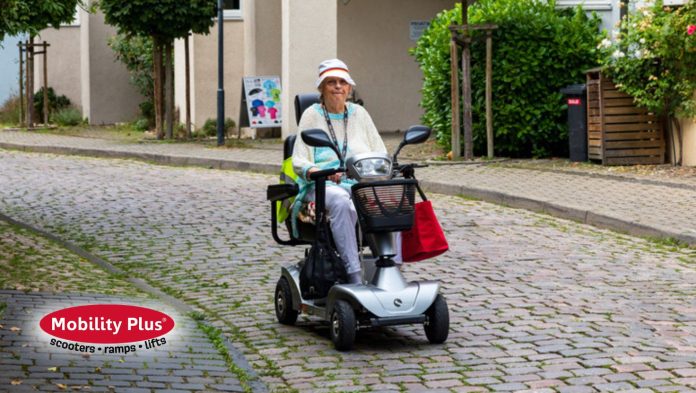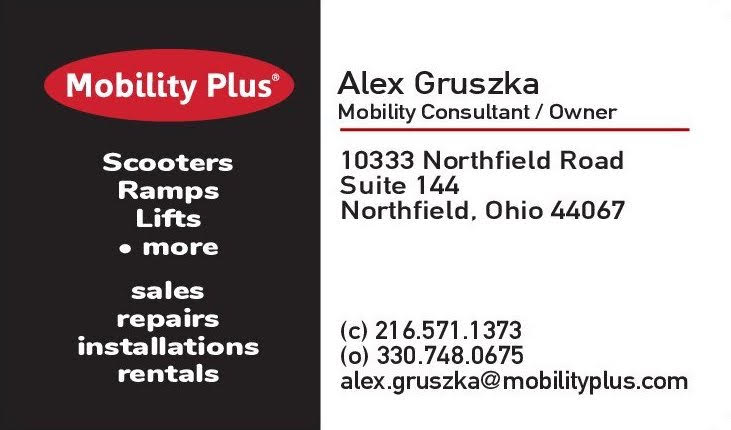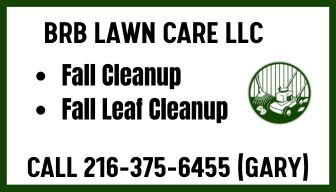Simple steps and surprising tricks can save money and keep your mobility device rolling smoothly
Proper tire maintenance is one of the most overlooked aspects of wheelchair and scooter care, yet it plays a crucial role in safety, performance, and the longevity of your mobility device. Whether you use a manual wheelchair, power wheelchair, or mobility scooter, understanding how to care for your tires can prevent costly repairs and ensure reliable operation.
Many users don’t realize that tire care goes far beyond checking air pressure. From seasonal considerations specific to Northeast Ohio’s climate to unexpected maintenance tricks that professionals use, a little knowledge can extend tire life significantly and keep you moving independently.
Understanding Your Tire Type
Mobility devices typically come with one of two tire types: pneumatic (air-filled) or solid (foam-filled or airless). Pneumatic tires offer a smoother ride and better shock absorption, making them ideal for outdoor use and varied terrain. They do require regular pressure checks and are susceptible to punctures.
Solid tires are maintenance-free regarding air pressure and won’t leave you stranded with a flat. However, they can wear down over time, may provide a firmer ride, and typically cost more to replace when they reach the end of their life.
Some newer mobility devices feature semi-pneumatic or foam-filled tires, which combine benefits of both types. These have an outer pneumatic tire filled with foam, providing puncture resistance while maintaining some shock absorption.
The Weekly Inspection Routine
Check your tires weekly for signs of wear, damage, or embedded debris. This five-minute routine can prevent breakdowns and catch problems early.
What to Look For:
Look for cuts, cracks, bulges, or uneven wear patterns that could indicate alignment issues. Run your hand along the tire surface to feel for embedded glass, nails, or stones that might not be visible. Check the tread depth on pneumatic tires and examine sidewalls for any deterioration or weather cracking.
Pay special attention to the inner sidewalls, which often show wear first but are easily missed during casual inspections. Use a flashlight to inspect these areas thoroughly.
For power wheelchairs and scooters, check the drive wheels more frequently than casters, as they bear more stress and wear faster. Uneven wear on drive wheels often indicates motor or controller issues that need professional attention.
Maintaining Proper Tire Pressure
For pneumatic tires, maintaining the correct air pressure is essential but frequently neglected. Under-inflated tires wear faster on the edges, reduce battery life on power devices by up to 30 percent, and make manual wheelchairs significantly harder to push. Over-inflation causes center wear, leads to a harsh ride, and increases puncture risk.
Check your owner’s manual for the recommended PSI, which varies by device and tire size. Use a reliable tire gauge monthly or before long trips. Don’t trust gas station gauges, which are often inaccurate for the lower pressures used in mobility equipment.
The Temperature Factor:
Here’s something most people don’t consider: tire pressure changes with temperature. For every 10-degree drop in temperature, tire pressure decreases by about one PSI. During Northeast Ohio’s winter months, check your tire pressure more frequently as temperatures fluctuate. A tire properly inflated at 70 degrees in your home may be significantly under-inflated when you head outside into 30-degree weather.
Store a portable hand pump with your device, especially during winter months. Battery-powered pumps designed for mobility equipment are available and take the guesswork out of maintaining proper pressure.
Keep Them Clean (Really Clean)
Dirt, debris, and moisture accelerate tire deterioration more than most users realize. The issue isn’t just cosmetic—certain substances actively break down rubber compounds.
Wipe down your tires regularly with a damp cloth to remove mud, salt, and other materials. This is especially critical during Northeast Ohio’s winter months when road salt is prevalent. Salt doesn’t just corrode metal components; it also degrades rubber and can cause premature cracking.
Avoid using harsh chemicals, armor-all type products, or petroleum-based cleaners that can break down rubber compounds. These products may make tires look shiny initially but actually accelerate aging. Use only mild soap and water, then dry thoroughly.
The Surprising Culprit:
Many people don’t realize that certain floor cleaners used in commercial buildings can damage wheelchair tires over time. If you notice unusual deterioration or sticky residue on your tires, consider the environments you regularly travel through. Wax-based floor polishes and certain cleaning solutions can build up on tires and attract debris.
Rotation Strategies Most People Miss
For devices with multiple wheels, rotating tires promotes even wear and extends overall tire life. This is particularly important for power wheelchairs and scooters since drive wheels wear significantly faster than casters.
When to Rotate:
Rotate tires every three to six months, depending on usage. Heavy daily users should rotate quarterly, while occasional users can extend to six months. Mark your calendar or set phone reminders to make this routine.
The Professional Secret:
Here’s what most users don’t know: always rotate in pairs and mark each tire’s position. Keep a simple log noting which tire was in which position and when you rotated. This helps you track wear patterns and identify alignment issues early. If one tire consistently wears faster regardless of position, that indicates a mechanical problem needing professional attention.
For manual wheelchairs, some users benefit from swapping casters from front to back on each side, as rear casters often wear differently due to weight distribution.
Terrain Awareness and Route Planning
The surfaces you travel on significantly impact tire longevity. Rough terrain, gravel, and glass pose greater risks to tire integrity than smooth pavement. However, terrain considerations go deeper than most people realize.
Avoid sharp objects, potholes, and curbs that could damage tires or wheels. When possible, choose smoother paths. But here’s the unexpected part: repeatedly traveling the exact same route can cause uneven wear patterns. Varying your route occasionally distributes wear more evenly across the tire surface.
The Curb Cut Consideration:
Always approach curb cuts straight on rather than at an angle. Angled approaches cause uneven stress on tires and can lead to premature wear on one side. This single habit can extend tire life by months.
For outdoor enthusiasts who regularly travel on trails or rough terrain, consider keeping a second set of tires specifically for off-road use. This protects your primary tires and provides better traction for different environments.
Storage Practices That Matter
When storing your mobility device for extended periods, keep it in a cool, dry place away from direct sunlight and extreme temperatures. UV rays and heat cause rubber to crack and deteriorate faster than normal use.
If possible, elevate the device slightly to prevent flat spots from developing on tires. Even solid tires can develop flat spots if left stationary too long under weight.
The Unexpected Storage Tip:
Before extended storage, slightly over-inflate pneumatic tires by about two PSI. This compensates for the slow air loss that occurs during storage and prevents tires from sitting too flat. Remember to return to proper pressure before use.
Cover tires with fabric or old towels if storing in a garage or shed where tires are exposed to sunlight through windows. Even indirect UV exposure accelerates rubber aging.
Professional Maintenance and Alignment
Schedule annual professional inspections with a qualified mobility equipment provider. Technicians can identify issues you might miss and ensure proper wheel alignment, which directly affects tire wear.
Alignment problems cause premature tire wear and can make devices harder to control. Signs of alignment issues include the device pulling to one side, uneven tire wear, or unusual vibration during movement.
Mobility Plus Northfield offers comprehensive tire services and can assess your specific needs. Professional technicians can also check for bearing wear, axle problems, and other mechanical issues that impact tire performance.
What Professionals Check That You Can’t:
Technicians measure alignment with specialized tools and check bearing play that isn’t apparent during casual use. They also inspect mounting hardware and can spot early signs of wheel damage before it causes tire problems. This preventive approach saves money by catching issues before they require major repairs.
Knowing When to Replace
Replace tires immediately if you notice cord or fabric showing through the rubber, significant sidewall damage, or if the tread is worn smooth. Don’t wait for a flat or blowout, which could leave you stranded or cause injury.
The Penny Test:
For tread depth on pneumatic tires, use the penny test borrowed from automotive care. Insert a penny into the tread with Lincoln’s head upside down. If you can see all of Lincoln’s head, the tread is too shallow and needs replacement.
Watch for these often-missed warning signs: a noticeable increase in vibration during movement, decreased traction on familiar surfaces, or your device feeling less stable than usual. These subtle changes often indicate tires nearing the end of their useful life.
Most manufacturers recommend tire replacement every one to two years, depending on usage. Heavy users may need more frequent replacements, while light users might extend this timeline. Keep purchase receipts and installation dates to track tire age.
The Northeast Ohio Challenge
Local weather conditions present unique challenges for mobility equipment tires. Freeze-thaw cycles cause pavement expansion that creates more cracks and hazards. Salt residue is highly corrosive. Sudden temperature changes affect tire pressure dramatically.
During winter, consider these Northeast Ohio-specific tips: Clean tires immediately after traveling on salted surfaces, check tire pressure more frequently as temperatures fluctuate, and be extra cautious on wet pavement where salt residue creates slippery conditions even without ice.
Spring brings its own challenges as potholes emerge and debris from winter cleanup litters sidewalks. Increase inspection frequency during seasonal transitions.
Emergency Preparedness
Carry basic tire supplies appropriate for your device type. For pneumatic tires, keep a portable pump, tire gauge, and patch kit. Know how to use them before you need them. For solid tires, keep contact information for mobile repair services that can assist if other mechanical issues arise.
Consider joining a roadside assistance program that covers mobility equipment. Several organizations offer specialized services for wheelchair and scooter users.
The Bottom Line
By following these maintenance practices, you can significantly extend the life of your wheelchair or scooter tires while ensuring optimal performance and safety. A few minutes of regular attention prevents hundreds of dollars in repairs and keeps you mobile and independent.
Remember that tires are your connection to the ground and your device’s only contact with the surfaces you travel. Treating them as critical safety components rather than afterthoughts pays dividends in reliability, comfort, and cost savings.
The investment in proper tire maintenance is minimal compared to the value of uninterrupted mobility and independence. Make tire care part of your regular routine, and your mobility device will reward you with years of reliable service.
More information about Mobility Plus Northfield here: Mobility Plus in Northfield





















